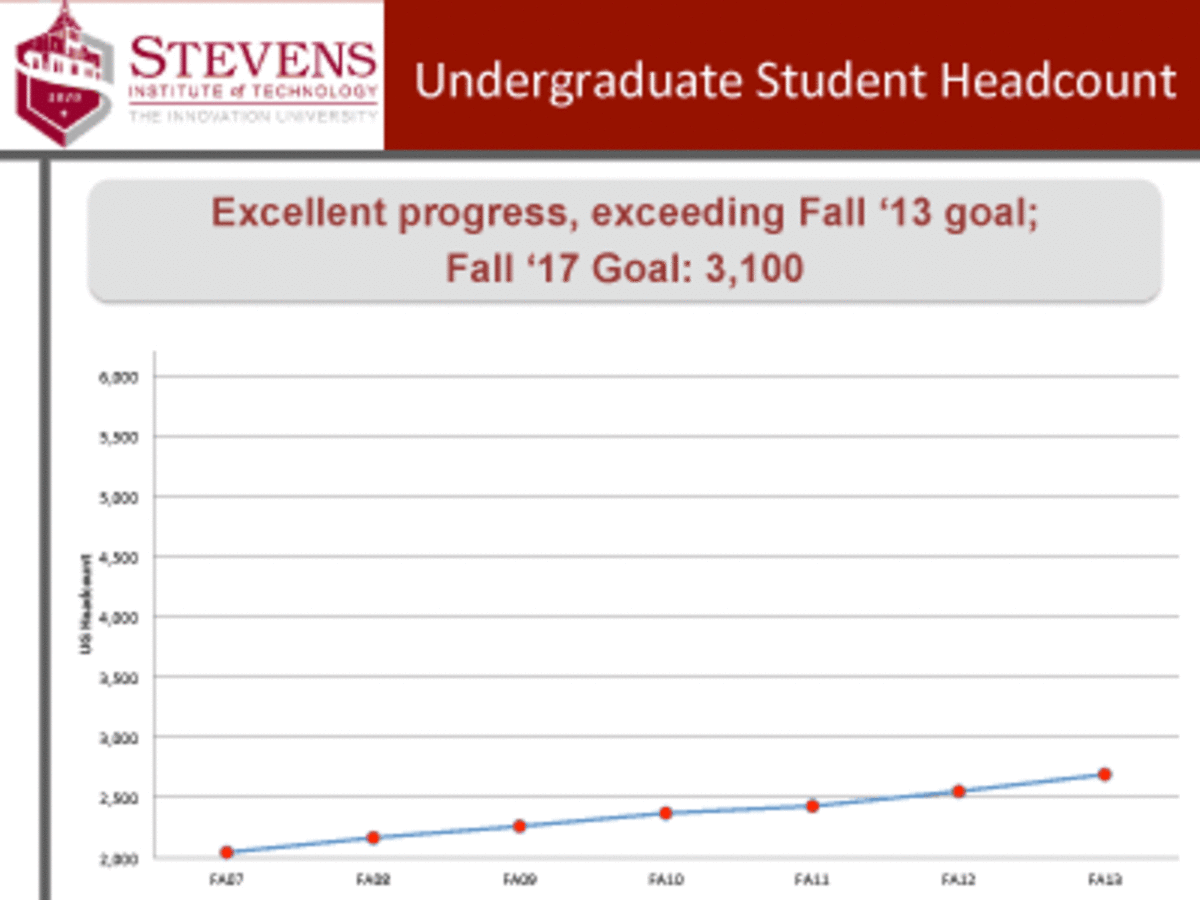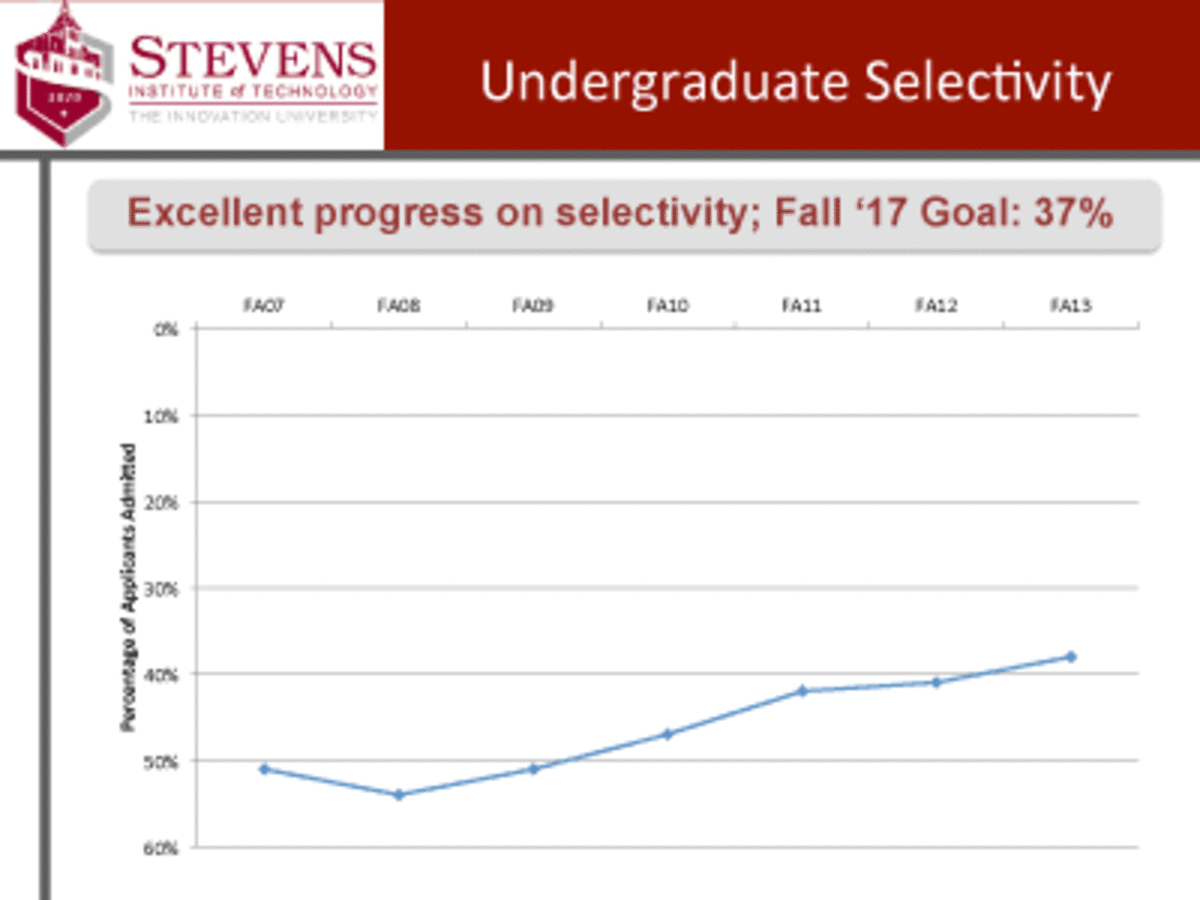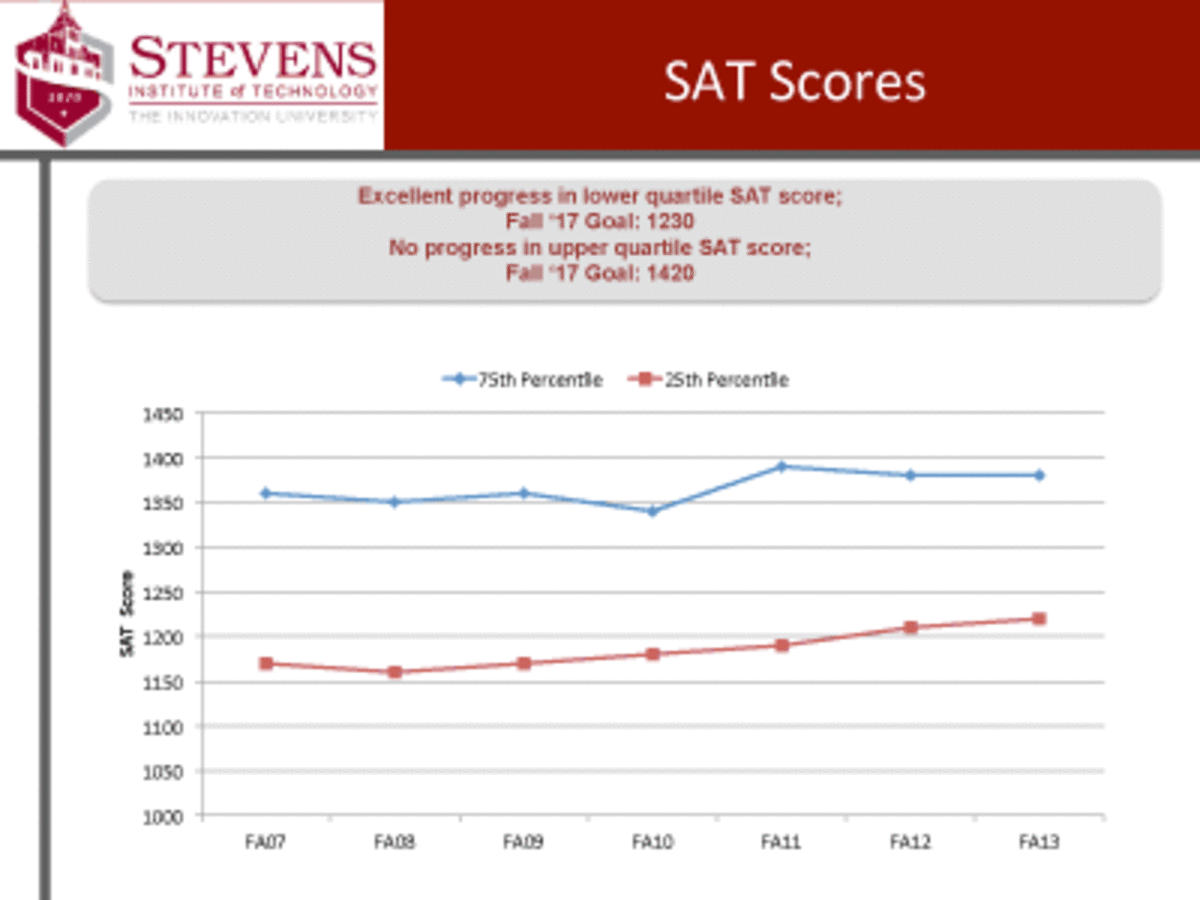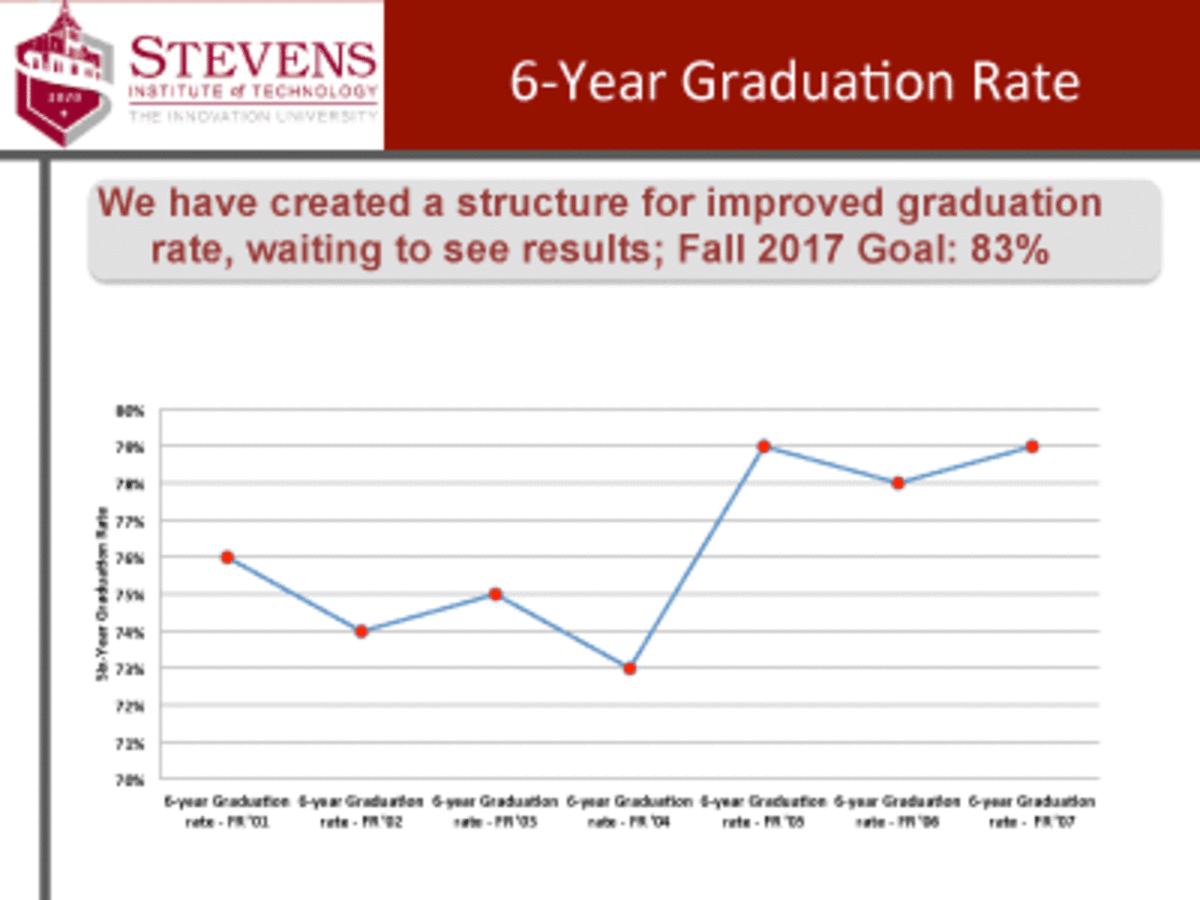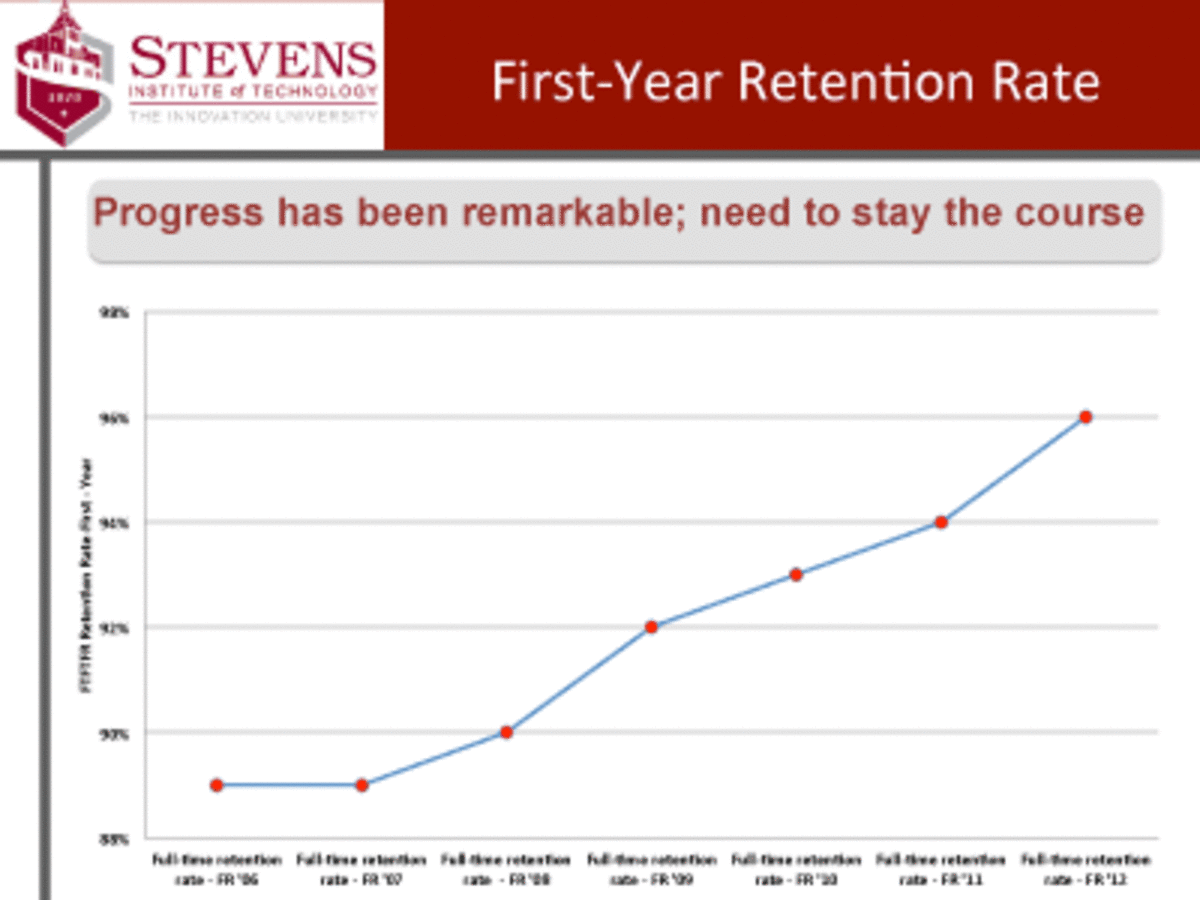Progress in increasing the size and academic profile of undergraduate students has been substantial. New organizational structures are contributing to improved retention rates and student success.
Goal U1
Stevens will have an undergraduate student enrollment of approximately 4,000 from a baseline of 2,427 in Fall 2011. The intermediate goal is to have an undergraduate enrollment of approximately 3,100 by 2017.
OWNER: VICE PRESIDENT MARYBETH MURPHY
For this Year 1 priority, in Fall 2013, undergraduate enrollment exceeded its target of 2,626 by 65 students (143 students more than Fall 2012). A 3.6 percent growth in the size of the Fall 2013 freshmen and transfer student cohort (excluding the Link program) and improved retention rates for upper class students contributed to this success. Increased outreach, communications, visits and improved response time in the application process; leveraging ROI news; and greater faculty involvement in recruiting contributed to progress in this area.
Year 2: Refine strategy; develop financial aid strategy; targeted efforts for areas of growth; increase guidance counselor efforts.
Goal U2
Continue to improve student selectivity and therefore the academic profile of the incoming class. Specifically, the percentage of first-time, full-time undergraduate applicants who are admitted will be 37 percent by 2017 and 33 percent by 2022, from a baseline of 42 percent in 2011. The middle 50 percent SAT score of new freshmen will improve to 1230-1420 by 2017 and 1280-1450 by 2022, from a baseline of 1190-1390 in Fall 2011.
OWNER: VICE PRESIDENT MARYBETH MURPHY
For this Year 1 priority, Stevens exceeded its Year 1 selectivity goal. The objective was to admit no more than 40 percent of students who applied for admission for Fall 2013; the actual acceptance rate was 38 percent. The Fall 2013 middle 50 percent SAT target for enrolled students was 1220-1390. The actual middle 50 percent SAT of Fall 2013 freshmen was 1220-1380.
Year 2: Refine strategy; develop financial aid strategy to achieve enrollment goals; maintain selectivity ratio of 38 percent; increase median SAT score; increase CAL, School of Business, out-of-state, women and underrepresented minority students in Fall 2014 cohort.
Goal U3
The six-year graduation rate will improve significantly with the goal of achieving at least 83 percent in Fall 2017 (for cohort of Fall 2011) and at least 87 percent in Fall 2022 (for cohort of Fall 2016).
OWNER: PROVOST GEORGE KORFIATIS
This was a Year 1 priority. The target retention rate for Fall 2012 returning freshmen was 94 percent; the actual retention rate was 96 percent. The target six-year graduation rate for the Fall 2007 cohort of students was 80 percent; the actual six-year graduation rate for this cohort was 79 percent. A new organizational structure, under a Vice Provost for Academics, was created. A student success strategy has been developed and is being implemented, including monitoring at-risk students, progress toward graduation, student support centers, improved advising/mentoring, and a revamped Calculus course.
Year 2: Build the Office of the Vice Provost for Academics and develop/refine a comprehensive student success strategy. Achieve first-year retention rate of 96 percent and six-year graduation rate of 81 percent.
Goal U4
Overhaul the academic schedule and implement curriculum changes with the aim of encouraging and facilitating an array of learning opportunities, including interdisciplinary research and development, critical thinking and problem-solving, community service, K-12 STEM mentoring and international experience (Curriculum ++). In May 2018, 100 percent of undergraduate students will graduate having participated in C++.
OWNER: PROVOST GEORGE KORFIATIS + FACULTY SENATE
While this was a Year 1 priority, minimal progress has been made in this area. This will be a focus in Year 2.
Year 2: Assemble team to define C++ learning experiences and non-traditional learning opportunities; assess student outcomes.
Goal U5
Maintain our stellar placement record for our students and seek to further improve it from our 2011 baseline of 92 percent of students securing post-graduation outcomes as of Nov. 1, 2011.
OWNER: VICE PRESIDENT MARYBETH MURPHY
This is a Year 3 priority. 94 percent of the Class of 2012 secured post-graduation outcomes as of Nov. 1, 2012; 94 percent of the Class of 2013 secured post-graduation outcomes as of Nov. 1, 2013. Activities included aggressive recruitment of new employers. In 2013, the largest career fair was held since the 2007 recession.
Year 2: Continued expansion of employer network.
Goal U6
Stevens will have designed, constructed and staffed a Digital Learning Laboratory (DLL), focusing on the research and practice of technology-enhanced learning across all three schools and CAL (by Fall 2017).
OWNER: PROVOST GEORGE KORFIATIS
A Year 2 priority, planning is already underway with initial concepts being developed and five patents and disclosures to date.
Year 2: Continue planning.
Goal U7
A sustained effort consisting of specific initiatives will be undertaken to improve our undergraduate faculty teaching performance and student learning.
OWNER: PROVOST GEORGE KORFIATIS
Activities toward this Year 1 priority include developing and deploying centralized student evaluation reports by school/program/faculty, and establishing a podcast studio to create learning artifacts (including live streaming from classroom) which has been used by more than 10 programs to date.
Year 2: Develop a cohesive and integrated plan, including policies, incentives, recognition/rewards, training/support and assessment/feedback for improved teaching and learning.
